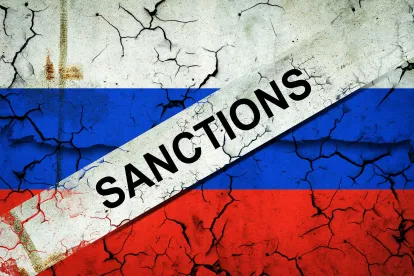In a set of actions in coordination with G7 allies, US and UK export control authorities recently announced significant escalations of sanctions and export controls against Russia and Belarus. These actions indicate continued multilateral commitment to pressure Russia and its ally Belarus over the ongoing military incursion into Ukraine, and they build upon already significant measures that are in place.
US MEASURES
BIS Issues Export Controls
The Bureau of Industry and Security of the US Department of Commerce (BIS) has issued a final rule imposing additional export controls on Russia and Belarus through expansion of existing restrictions under the Russia/Belarus foreign direct product rule (FDPR) and industry sector sanctions, designation of additional persons and entities on the BIS Entity List, and also through clarifications and conforming changes to prior iterations of the Russia-related restrictions. The final rule, “Implementation of Additional Sanctions Against Russia and Belarus Under the Export Administration Regulations (EAR) and Refinements to Existing Controls,” was effective 19 May and is available in full here. Below is a brief analysis of the prominent changes effected in the rule.
Expansion of Industry Sector Sanctions
BIS broadened existing industry sector sanctions applicable to Russia, including a ban on exports and re-exports of a variety of machinery, electronics, cameras and optical devices, and chemical compounds. Russia and Belarus Industry Sector Sanctions are set out in Section 746.5 of the EAR,1 with the restricted products identified in Supplement Nos. 2, 4, and 6 to part 746 of the EAR. Complete export bans for all items subject to the EAR destined to Russia or Belarus, without a license, are set out in 15 C.F.R. § 746.5(a)(1)(ii)–(iii), with the corresponding items outlined in Supplement Nos. 4 and 6, respectively.
Effective 19 May, the restrictions imposed by 15 C.F.R. § 746.5(a)(1)(ii) and (iii) in Supplement Nos. 4 and 6 were extended. First, BIS expanded the list of items subject to the export ban outlined in Supplement No. 4 to add 1,224 new six-digit Harmonized Tariff Schedule (HTS) codes to the list of items covered by 15 C.F.R. § 746.5(a)(1)(ii). The new six-digit HTS codes added to the list cover primarily industrial items and materials. Most notably for exporters, however, is that the restrictions imposed by Supplement No. 4 now cover all six-digit HTS codes falling within chapters 84 (“Nuclear reactors, boilers, machinery, and mechanical appliances; parts thereof”), 85 (“Electrical machinery and equipment and parts thereof; sound recorders and reproducers, television image and sound recorders and reproducers, and parts and accessories of such articles”), and 90 (“Optical, photographic, cinematographic, measuring, checking, precision, medical or surgical instruments and apparatus; parts and accessories thereof”). Importantly, these items require a license whether or not they are identified on the EAR’s Commerce Control List or classified as EAR99.
Likewise, the restrictions imposed by 15 C.F.R. § 746.5(a)(1)(iii) in Supplement No. 6, which previously covered only certain items useful to chemical and biological weapons production capabilities, were also expanded. The list was revised to add four chemicals—lithium chloride, lithium chloride hydrate, lithium chloride monohydrate, and lithium carbonate—as controlled chemicals. Alongside this change, BIS acknowledged that these chemicals were “not of concern” for chemical and biological weapons production and expanded the introductory language to the provision to state that the items covered by this restriction were targeted at chemical and biological weapons production “or other activities of concern” (emphasis added).
Expansion of FDPR Restrictions and Restrictions Targeting Russia’s Use of Iranian UAVs
Previously, on 24 February 2023, BIS announced new Russia-related export controls (the Iranian UAV Rule) targeting Russia’s use of Iranian unmanned aerial vehicles (UAVs). The complete rule, “Export Control Measures Under the Export Administration Regulations (EAR) To Address Iranian Unmanned Aerial Vehicles (UAVs) and Their Use by the Russian Federation Against Ukraine,” was published in the Federal Register on 27 February 2023 and can be viewed here. The Iranian UAV Rule primarily functions through: (1) licensing requirements for certain items destined to Iran, including some EAR99 items, identified in Supplement No. 7 to Part 746 of the EAR; (2) the expansion of the Russia/Belarus FDPR to include foreign-produced items identified in Supplement No. 7; and (3) a FDPR directed at foreign-produced items destined to Iran (the Iran FDPR).
BIS created Supplement No. 7 to Part 746 of the EAR identifying items used in Iranian UAVs that require a license under 15 C.F.R. § 746.7 when subject to the EAR and destined for Iran, and 15 C.F.R. § 746.8 when destined to Russia or Belarus (regardless of whether the items will actually be used in UAVs or other systems). The products subject to control are identified by six-digit HTS codes, like the industry sector sanctions identified above, and include specified engines and related parts; processing units; machines for the reception, conversion, and transmission or regeneration of voice, images, or other data; radio navigational aid apparatus; capacitors; processors and controllers; memories; amplifiers; and electronic integrated circuits.
Effective 19 May 2023, BIS expanded the rule to add one additional six-digit HTS code, 854800, which broadly provides for electrical parts of machinery or apparatus that are not elsewhere specified or included. Accordingly, products falling under HTS 854800 that are subject to the EAR will now require a license for export to Iran, Russia, or Belarus. Furthermore, the Iran FDPR and Russia/Belarus FDPR both cover items identified in Supplement No.7, detailed above, when foreign-produced from certain US-origin technology or software or with certain equipment, if destined to Iran, Russia, or Belarus, respectively, where the requirement of the FDPR is met. The inclusion of products classified under six-digit HTS code 854800 will therefore expand the number of items captured by these FDPRs. This will require a deeper dive into related supply chains to ensure that components being produced outside the United States are not violating the expanded reach of this rule.
Expansion of Russia/Belarus FDPR to Include Crimea
In addition to its expansion by virtue of the revisions to Supplement No. 6, and 7, both of which are within the product scope of the Russia/Belarus FDPR of 15 C.F.R. § 734.9(f), the Russia/Belarus FDPR destination scope was also expanded to include the Crimea region of Ukraine. Under the rule, foreign-produced items specified in any Export Control Classification Number (ECCN) on the Commerce Control List (CCL) or in Supplement Nos. 6 or 7 will become subject to the EAR if they are the “direct product” of US-origin “technology” or “software” subject to the EAR and specified in any ECCN in product groups D or E of the CCL or the “direct product” of a complete plant or major component of a plant that is itself a direct product of such “software” or “technology.” As revised, such items will become “subject to the EAR” when destined not only to Russia or Belarus, but also to the Crimea region of Ukraine. The Crimea region of Ukraine is defined to include “the land territory in that region as well as any maritime area over which sovereignty, sovereign rights, or jurisdiction is claimed based on occupation of that land territory.” 15 C.F.R. § 746.6(d)(1).
Entity List Designations
Separately, BIS announced the addition of 71 entities to the Entity List for their support of Russia’s military and defense sectors. The newly designated entities are based in Armenia, Kyrgyzstan, and Russia, and the complete list of entities, along with the specific restrictions applicable to each, can be found here.
OFAC Imposes New Sanctions Targeting Russia
Also on 19 May 2023, the Office of Foreign Assets Control of the US Department of the Treasury (OFAC) announced a group of actions and designations targeting Russia.
Prominently, OFAC issued an amended Directive 4 under Executive Order 14024 imposing certain reporting requirements on US persons holding property in which Directive 4 entities have any interest. Issued shortly following the Russian Federation’s invasion of Ukraine in February 2022, Directive 4 broadly prohibited US persons from engaging in transactions involving the Central Bank of the Russian Federation, the National Wealth Fund of the Russian Federation, and the Ministry of Finance of the Russian Federation. As amended by this latest action, Directive 4 now requires US persons “who are in possession or control of property in which any entity determined to be subject to the prohibitions of [Directive 4] has an interest of any nature whatsoever, direct or indirect,” to file an annual report of such property, along with a list of specified information on the property and individuals/entities involved. The initial report is required to be filed by 18 June 2023, and an annual report must be filed each year thereafter before 30 June.
OFAC also issued a Determination Pursuant to Section 1(a)(i) of Executive Order 14024 (the EO 14024 Determination), as well as a Determination Pursuant to Section 1(a)(ii) of Executive Order 14071 (the EO 14071 Determination), both of which further magnify restrictions on dealings involving parties in Russia or operating in defined sectors of the Russian economy.
The EO 14071 Determination expands the scope of existing restrictions on the export of specified services to the Russian Federation to include architectural and engineering services effective at 12:01 AM EDT on 18 June 2023. Following the EO 14071 Determination, “the exportation, reexportation, sale, or supply, directly or indirectly, from the United States, or by a United States person, wherever located, of architecture services or engineering services to any person located in the Russian Federation” is prohibited, with limited exceptions detailed in the EO 14071 Determination. Under the EO 14024 Determination, sanctions are now authorized for operating in additional sectors of the Russian economy. Specifically, any person determined to operate or who has operated in the architecture, engineering, construction, manufacturing, and transportation sectors of the Russian Federation economy may be sanctioned pursuant to Section 1(a)(i) of EO 14024. The EO 14024 Determination significantly increases the risk that parties operating in these sectors in Russia may be subject to future sanctions designation by OFAC.
Outside of these actions, OFAC designated 22 individuals and 104 entities on the Specially Designated Nationals and Blocked Persons List for various levels of involvement in support of Russia’s ongoing war against Ukraine. A complete list of the designated individuals and entities can be found here.
OFAC also issued a variety of updated General Licenses, most to allow a wind-down of transactions following the new designations. The updated General Licenses are listed and linked below:
- General License 13E, “Authorizing Certain Administrative Transactions Prohibited by Directive 4 under Executive Order 14024.”
- General License 66, “Authorizing the Wind Down of Transactions Involving Public Joint Stock Company Polyus.”
- General License 67, “Authorizing Certain Transactions Related to Debt or Equity of, or Derivative Contracts Involving, Public Joint Stock Company Polyus.”
- General License 68, “Authorizing the Wind Down of Transactions Involving Certain Universities and Institutes.”
UK MEASURES
The United Kingdom has implemented the most severe package of sanctions ever imposed on a major economy to undermine Russia’s war effort. To date, the United Kingdom has sanctioned over 1,500 individuals and entities, freezing more than £18 billion of assets in the United Kingdom, and sanctioned over £20 billion of UK-Russia goods trade. Below is a summary of actions taken in April 2023, followed by a summary of the May 2023 actions in coordination with the US measures described above.
April 2023 Amendment
In April, the United Kingdom introduced a ban on all items that Russia has been found using on the battlefield to date. The United Kingdom adopted The Russia (Sanctions) (EU Exit) (Amendment) Regulations 2023. See here for an explanatory memorandum accompanying this legislation. The new legislation introduced and expands on current trade sanctions and came into on 21 April 2023.
The sanctions significantly expand the restrictions on the import and acquisition of revenue-generating goods that originate in, or are consigned from, Russia.
This means that there are now two lists of “revenue-generating goods” restricted for import into the United Kingdom (Schedules 3D and 3DA), with some goods additionally restricted for UK persons to be involved in a supply to a third country (those listed in Schedule 3DA). Technical assistance, financial services and funds, and brokering services, in respect to a prohibited supply of these goods, is also prohibited.
The sanctions imposed a prohibition on the import of iron and steel products where the metal originated in Russia but was processed in a third country (i.e., not the United Kingdom, Isle of Man, or Russia), and technical assistance, financial and brokering services relating to such products. This does not come into force until 30 September 2023.
May 2023 Announcement
The United Kingdom has already taken a lead on action on Russian diamonds, sanctioning the state-owned company Alrosa and hiking tariffs by an additional 35%.
On 19 May 2023, the United Kingdom announced a ban on Russian diamonds, an industry worth US$4 billion in exports in 2021, as well as imports of Russian-origin copper, aluminum, and nickel. This ban will be implemented later this year. The prohibition will build on the existing bans on iron and steel.
Alongside these trade measures, the UK government has imposed an additional 86 individual designations targeting people and companies from Russia’s military-industrial complex, as well as those involved in key revenue streams such as energy, metals, and shipping. They include those supporting the Kremlin to actively undermine the impact of existing sanctions, as the United Kingdom continues to work with G7 partners to tackle all forms of sanctions circumvention.
1 15 C.F.R. § 746.5.







 />i
/>i
